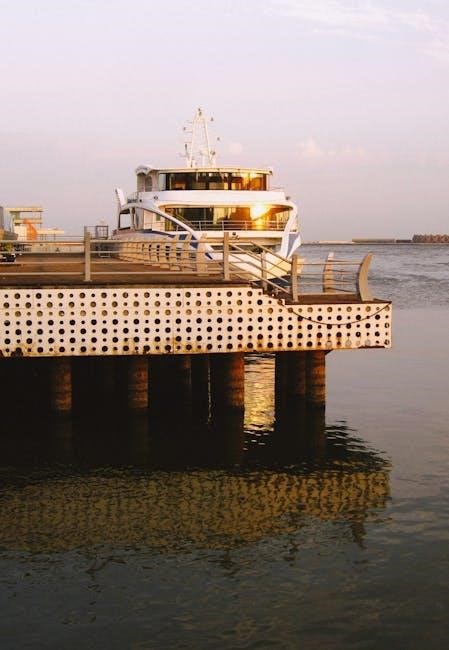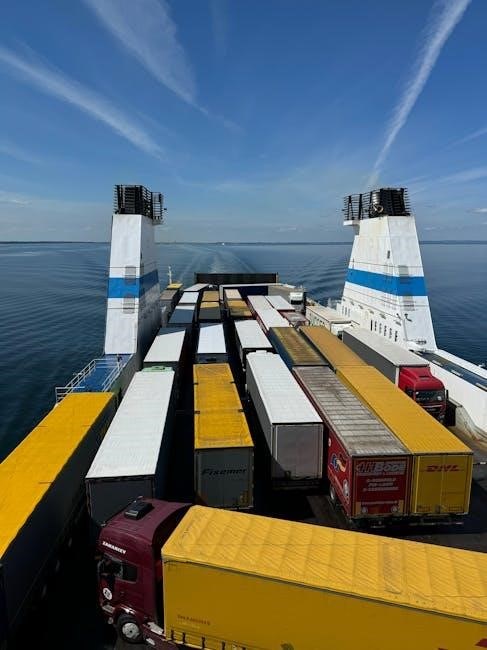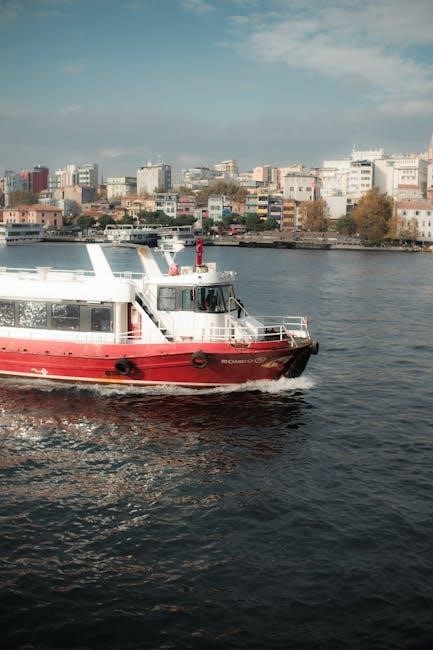port of tyne departures today map pdf
The Port of Tyne, located on England’s northeast coast, is a vital hub for international trade, handling diverse cargo and offering efficient maritime services.
1.1 Location and General Overview
The Port of Tyne is strategically situated on the northeast coast of England, along the River Tyne. It operates several key facilities, including Tyne Dock, located approximately two nautical miles from the river’s mouth. The port handles a diverse range of cargo, such as containers, Ro-Ro (roll-on/roll-off) shipments, steel, forest products, and petroleum coke; Owned and managed by the Port of Tyne Authority, it plays a crucial role in regional and international trade, offering efficient logistics and maritime services. Its prime location enables seamless connectivity to global markets, making it a vital economic hub in the UK.
1.2 Historical Significance
The Port of Tyne boasts a rich history dating back to medieval times, serving as a vital trade and maritime hub. Historically, it was a key center for the shipping of coal, earning its reputation as the “Lifeblood of the North East.” During the Industrial Revolution, the port played a pivotal role in the UK’s economic growth. In the 20th century, it adapted to modern trade demands, transitioning from coal to diversified cargo handling. Today, the port continues to honor its heritage while embracing innovation, marking 25 years since its transformation into a modern, multi-purpose facility in 1998.
Real-Time Updates on Port of Tyne Departures
Real-time updates on vessel movements are available via MarineTraffic and VesselFinder, providing current departures, arrivals, and weather data using AIS technology.
2.1 Current Vessel Departures
Real-time tracking of vessel departures from the Port of Tyne is accessible through platforms like MarineTraffic and VesselFinder. These services utilize AIS (Automatic Identification System) data to provide accurate updates on ship movements.
- Users can view live maps showing current vessel positions and departure times.
- Estimated Times of Arrival (ETA) and departure times are updated continuously.
- Weather conditions and wind forecasts are also available to aid planning.
This information is essential for logistics, shipping companies, and passengers relying on the Port of Tyne for timely operations.
2.2 Expected Arrivals and Port Calls
Expected arrivals and port calls at the Port of Tyne are tracked using AIS data, providing real-time updates on vessel movements. VesselFinder and MarineTraffic offer detailed schedules, including estimated arrival times and ship details. Users can access live maps to monitor incoming vessels and plan accordingly. Weather forecasts and port conditions are also integrated to ensure smooth operations. This data is crucial for shipping companies, logistics teams, and passengers relying on the Port of Tyne for efficient maritime services. Regular updates ensure accuracy, helping stakeholders stay informed about vessel movements and schedules.
2.3 Wind Forecast and Weather Conditions
Wind forecasts and weather conditions at the Port of Tyne are critical for maritime operations. MarineTraffic and VesselFinder provide real-time weather data, including wind speed and direction, using models like GFS. Accurate forecasts ensure safe navigation and efficient port operations. Weather alerts are issued for extreme conditions, such as storms, which can impact vessel movements. The port’s weather data is updated regularly, helping stakeholders plan accordingly. These forecasts are essential for minimizing delays and ensuring the safety of ships and crew. Reliable weather information is a key component of the port’s operational efficiency and safety standards.

Vessel Tracking and Monitoring
Vessel tracking at the Port of Tyne relies on AIS data processing, providing real-time updates on ship movements. Platforms like MarineTraffic and VesselFinder offer interactive maps for monitoring.
3.1 AIS Data Processing
AIS (Automatic Identification System) data processing is crucial for real-time vessel tracking at the Port of Tyne. This system collects and processes information such as vessel positions, speeds, and destinations, enabling accurate monitoring of maritime activities. By integrating AIS data with advanced algorithms, platforms like VesselFinder and MarineTraffic provide detailed insights into ship movements. Weather forecasts, derived from the GFS model, further enhance the accuracy of vessel tracking. This data is essential for ensuring safe navigation, efficient port operations, and timely updates for stakeholders. While AIS data is reliable, limitations exist, particularly for premium users with access to expanded datasets and satellite tracking.
3.2 MarineTraffic Interactive Map
The MarineTraffic Interactive Map provides real-time tracking of vessels at the Port of Tyne, offering a visual representation of maritime activity. Users can explore ship positions, speeds, and headings through interactive icons. The map features overlays for weather conditions, port layouts, and berth allocations, enhancing situational awareness. It supports environmental monitoring and operational planning, with data updated regularly for accuracy. This tool is invaluable for port authorities, shipping operators, and enthusiasts, delivering insights into the Port of Tyne’s dynamic maritime environment.
3.4 VesselFinder Data Accuracy
VesselFinder relies on AIS data and weather models like GFS for real-time updates on Port of Tyne departures. While the platform strives for accuracy, it notes that data is for informational purposes only. Users should be aware of potential delays or discrepancies in vessel tracking. Premium users gain access to more detailed and reliable information, while free users may see limited results. The port’s dynamic environment and technical challenges can affect data precision, making VesselFinder a useful but not entirely flawless tool for maritime monitoring and planning.

Importance of the Port of Tyne in Trade
The Port of Tyne is a strategic hub for UK trade, handling diverse cargo like containers, Ro-Ro, steel, and forest products, connecting the region to global markets efficiently.
4.1 Cargo Handling Capacities
The Port of Tyne specializes in handling a diverse range of cargo, including containers, Ro-Ro (roll-on/roll-off) cargo, steel, forest products, petroleum coke, fertilizers, and aggregates. With state-of-the-art terminals and berths, the port ensures efficient cargo processing and storage. Tyne Dock, located on the south side of the river, approximately 2 nautical miles from the mouth, is a key facility for these operations. The port’s capacity to handle large volumes of cargo makes it a critical gateway for trade in the northeast of England, supporting both regional and national economic activities while maintaining high operational standards and environmental compliance.
4.2 Major Trading Routes
The Port of Tyne is strategically connected to key European and global markets through its major trading routes. One of its prominent routes is the daily DFDS ferry service between North Shields and IJmuiden in the Netherlands, facilitating both cargo and passenger movements. This route supports the Newcastle-Amsterdam mini-cruise, attracting tourists and enhancing trade links. Additionally, the port’s proximity to North Sea shipping lanes enables efficient connections to other European ports and international destinations, making it a vital gateway for trade in the northeast of England. These routes underscore the port’s role in supporting regional and national economic activities.
Port Facilities and Infrastructure
The Port of Tyne features modern terminals, berths, and recently upgraded facilities, including a reconfigured International Passenger Terminal for Marella Cruises, enhancing cargo and passenger handling efficiency.
5.1 Terminals and Berths
The Port of Tyne boasts extensive terminal and berth facilities, including the Tyne Dock, situated approximately 2 nautical miles from the river mouth. These terminals handle a wide range of cargo, such as containers, Ro-Ro, steel, and forest products. The International Passenger Terminal in North Shields has been reconfigured to enhance baggage handling for Marella Cruises, reflecting the port’s commitment to efficiency. Berths are equipped to accommodate diverse vessel types, ensuring smooth operations for both cargo and passenger services. Recent upgrades have further strengthened the port’s capacity to manage increasing trade volumes and diverse maritime activities.

5.2 Recent Expansions and Upgrades
The Port of Tyne has recently undertaken significant expansions and upgrades to enhance its operational efficiency. The International Passenger Terminal has been reconfigured to improve baggage handling for Marella Cruises, creating a 300-square-meter facility and a marquee for undercover processing. These upgrades aim to streamline operations and increase capacity. Additionally, the port has invested in modernizing its berths and terminals to accommodate larger vessels and handle diverse cargo types. Such improvements underscore the port’s commitment to maintaining its position as a key player in global trade and maritime services.

Environmental Sustainability Initiatives
The Port of Tyne actively promotes green port initiatives and carbon reduction measures, focusing on renewable energy adoption and emission reduction to achieve its sustainability goals;
6.1 Green Port Initiatives
The Port of Tyne has implemented green port initiatives to minimize environmental impact. These include investments in renewable energy sources, such as wind and solar power, to reduce carbon emissions. The port has also adopted energy-efficient technologies and waste management systems to enhance sustainability. Additionally, the port collaborates with local organizations to promote eco-friendly practices and reduce pollution in the surrounding areas. These efforts align with global environmental standards, ensuring the port remains a leader in sustainable maritime operations while supporting the region’s economic growth and environmental preservation.
6.2 Carbon Reduction Measures
The Port of Tyne has committed to reducing carbon emissions through targeted measures. Investments in renewable energy, such as wind and solar power, are central to its strategy. The port has also implemented energy-efficient technologies, including electrification of berths, to lower fuel consumption and emissions. Additionally, the port promotes the use of cleaner fuels and partners with organizations to develop sustainable practices. These initiatives aim to achieve net-zero emissions by 2050, aligning with global climate goals. By integrating innovative solutions and fostering collaboration, the Port of Tyne is leading the way in reducing its carbon footprint while maintaining operational efficiency and supporting environmental sustainability.

Passenger Services and Ferries
The Port of Tyne offers DFDS ferry services, operating daily routes to Amsterdam, while its cruise terminal in North Shields supports passenger travel and tourism activities effectively.
7.1 DFDS Ferry Services
DFDS operates a daily ferry service from the Port of Tyne, connecting North Shields to Amsterdam. This route is popular for both passenger travel and freight transport, offering a convenient link between the UK and mainland Europe. The ferry service provides comfortable onboard amenities, including cabins, dining options, and entertainment facilities, making it a preferred choice for travelers. Check-in procedures are efficient, with clear guidelines for passengers and vehicles. Real-time updates on departures and arrivals are available through the Port of Tyne’s official channels, ensuring smooth journey planning. This service plays a significant role in fostering trade and tourism between the regions.
7.2 Cruise Terminal Facilities
The Port of Tyne’s International Passenger Terminal in North Shields offers state-of-the-art cruise terminal facilities. Recent expansions include a dedicated baggage handling area for Marella Cruises, enhancing efficiency for passengers. The terminal features a 300-square-meter reconfigured space and a marquee for undercover baggage processing, capable of handling up to 1,000 bags. These upgrades ensure seamless operations for cruise liners, providing a comfortable and modern environment for travelers. The facility’s strategic location and improved infrastructure make it an attractive destination for cruise operators, boosting tourism and economic growth in the region.

Safety and Security Measures
The Port of Tyne prioritizes safety with Tyne VTS and pilotage services, ensuring secure vessel movements and expert guidance. Conservancy and workboat services maintain safe navigation channels.
8.1 Tyne VTS (Vessel Traffic Services)
Tyne VTS provides real-time monitoring and management of vessel traffic within the Port of Tyne, ensuring safe and efficient navigation. Using advanced AIS data and radar surveillance, Tyne VTS tracks vessel movements, predicts potential conflicts, and offers navigational guidance. Operated 24/7, it plays a critical role in maintaining maritime safety, particularly during challenging weather conditions. The service also assists in coordinating pilotage and berth allocation, ensuring smooth operations. Tyne VTS is integral to the port’s safety framework, enhancing situational awareness and reducing risks for all vessels operating in the region. Its expertise ensures compliance with international maritime regulations.
8.2 Pilotage Services
Pilotage services at the Port of Tyne are essential for guiding vessels safely through the River Tyne. Experienced pilots, with extensive local knowledge, board ships to assist captains in navigating the port’s complex waterways. This service ensures safe passage, especially for large or unfamiliar vessels. Pilots are trained to handle diverse conditions, including strong currents and limited visibility. They work closely with Tyne VTS to coordinate movements, minimizing risks and ensuring efficient berthing and departure processes. The expertise of Port of Tyne pilots is crucial for maintaining operational safety and smooth maritime traffic flow within the port.
Future Plans and Investments
The Port of Tyne is investing in expansion projects and technological advancements to enhance its capacity and efficiency, ensuring its role as a key player in global trade.
9.1 Expansion Projects
The Port of Tyne is undergoing significant expansion projects to enhance its infrastructure and capacity. These include upgrades to berths, deeper navigation channels, and improved cargo handling facilities. The port aims to accommodate larger vessels and increase efficiency in trade operations. Additionally, there are plans to develop new terminal spaces to support growing industries such as offshore wind and renewable energy. These initiatives are part of the Tyne 2050 strategy, focusing on long-term growth and sustainability. The expansions will also incorporate green technologies to reduce environmental impact, aligning with the port’s commitment to innovation and eco-friendly practices.
9.2 Technological Advancements
The Port of Tyne is embracing technological advancements to enhance efficiency and sustainability. AI and IoT are being integrated to optimize cargo handling and vessel tracking. Real-time data systems, like those from MarineTraffic, provide precise updates on vessel movements and weather conditions. Automation is streamlining operations, reducing manual errors, and improving decision-making. Additionally, the port is leveraging data analytics to predict trends and improve resource allocation. These innovations ensure the port remains competitive, supporting its role as a key player in global trade. Future plans include further adoption of cutting-edge technologies to maintain its position as a leader in modern maritime operations.

Visitor Guide
Explore the Port of Tyne’s vibrant surroundings, featuring iconic landmarks like the Quayside and Millennium Bridge. Discover nearby attractions, cultural spots, and a range of accommodation options.
10.1 Nearby Attractions
The Port of Tyne is surrounded by a wealth of cultural and natural attractions. Visitors can explore the iconic Quayside, adorned with the Millennium Bridge, offering stunning views. Tynemouth Castle and Priory, a historic fortress, is a short journey away. The vibrant city of Newcastle-upon-Tyne boasts world-class museums like the Discovery Museum and the BALTIC Centre for Contemporary Art. Nature lovers can enjoy the picturesque Northumberland coastline, while families can visit the Blue Reef Aquarium in Tynemouth. The region also features charming coastal villages and scenic walking trails, making it a diverse destination for all interests.
10.2 Accommodation Options
Near the Port of Tyne, visitors can choose from a variety of accommodation options to suit all preferences and budgets. Newcastle-upon-Tyne offers luxury hotels, boutique guesthouses, and budget-friendly B&Bs, many located near the Quayside. The port’s proximity to vibrant city life ensures easy access to top-rated amenities. Travelers can also opt for cozy self-catering apartments or seaside lodgings in nearby Tynemouth, perfect for exploring the coast. With Wi-Fi, dining options, and excellent transport links, these accommodations cater to both leisure and business travelers. Booking in advance is recommended, especially during peak travel seasons.
The Port of Tyne stands as a vital maritime hub, strategically located on England’s northeast coast, ensuring efficient trade and travel while embracing sustainability and future growth initiatives.
11.1 Strategic Role of the Port
The Port of Tyne plays a pivotal role in regional and international trade, serving as a gateway for diverse cargo and passenger services. Its strategic location on England’s northeast coast enables efficient connectivity to global markets, supporting industries such as logistics, manufacturing, and energy. The port’s ability to adapt to economic demands, combined with its commitment to sustainability, underscores its importance as a hub for commerce and travel. Recent investments in infrastructure and technology further cement its position as a key player in maritime trade, ensuring long-term growth and resilience in an evolving global landscape.
11.2 Future Outlook
The Port of Tyne is poised for continued growth, with strategic investments in infrastructure and technology driving its evolution. Plans for expansion aim to enhance cargo handling capacities and improve efficiency, ensuring the port remains competitive in global trade. Sustainability initiatives, such as green port projects, will play a key role in reducing environmental impact while maintaining economic viability. The integration of advanced systems for real-time vessel tracking and weather monitoring underscores the port’s commitment to innovation. As a gateway for trade and tourism, the Port of Tyne is well-positioned to adapt to future challenges and opportunities, solidifying its role as a leader in maritime operations.